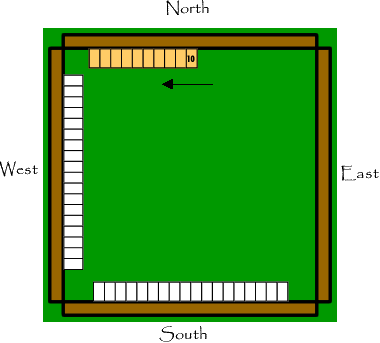4. INSTALL YOUR PLANTER
Mah-jong is played at a table -- any shaped table will do, as long as players can't peek at one another's tiles. Exactly four people must play at a time, so gather three of your friends and make the rest study step three as they wait for their turn.
Seating
- Sit everyone down.
- Have each player roll the dice.
- The highest roll gets to be East, the dealer. (If there's a tie, have a "roll-off.")
- Going counter-clockwise from East is North, then West, and finally South. The wind direction that is assigned to each player will matter later when points are totaled. But for now, the only direction of importance is East.
- East is the dealer of the first round, and this means that he gets to begin the game. East also becomes the prevailing wind of the round, which will also affect scoring later on.
- Unless the East player wins the round, the next round will be dedicated to the South wind, where South is the dealer and South is the prevailing wind.
- The "dealer" role shifts counter-clockwise with each round, unless the current dealer wins the round, in which case he gets to keep the dealer status until he/she loses.
Building the walls
Now here comes the fun part. Dump all the mah-jong tiles on the table (face down) and start mixing them all around. Everyone should get their hands, arms, and elbows into the pile and mix the tiles around enthusiastically until they're all completely mixed up.
The next step is to build four "walls" of tiles:
- Have each player arrange one long row of 18 tiles (face down) in front of their own rack.
- Then have each player add another row right on top of the first one (also face down), to make a long wall of 36 tiles total. Yes, this means that you have a row of 18 tiles across, 2 tiles tall. Once each player has 36 tiles, there should be no more tiles left in the middle.
- The racks will come in handy for neat wall-building: push the tiles against the rack to make your tile row nice and even.
- Next, carefully push the four walls together to form a square with an empty playing space in the middle. Here's what the table should look like:

Dealing
- The dealer (East, in the first round) begins the game by rolling all three dice onto the middle of the table.
- Use the number rolled to count counterclockwise, starting with the dealer.
- The wall that the final count lands on is to be dismantled first.
- From the right of the wall, count the number rolled starting at the right in the stacks of tiles. Here's an example: if the dealer rolled the three dice and got a 5, 3, and 2, then the total would be 10:

Going counter-clockwise starting with East as 1, the North would be dismantled first. So North would look at his stack of tiles (18 across, 2 deep), and starting on hisright, counts across 10:
- Here is where East begins dealing the tiles. East starts by grabbing the first two stacks (4 tiles) to the right of the counted stack from the chosen section of the wall. So in our example, the East would reach over and take stacks 11 and 12 and put them in front of his rack.
- Then going counter-clockwise (as always), North is given the next two stacks to the left of the empty space, then West the next two stacks, then West, then South, then East again.
- This is repeated until this has been done three times each. When the dealer gets to the end of a row, he just continues taking stacks from the next wall. At the end, each player should have a total of 12 tiles.
- The dealer then draws two more tiles (one stack) for himself, making his total number of tiles 14. So now our example setup would look like this:

- Next, the dealer deals one tile to North, one to West, and one to South (draw the tiles in the order of top, bottom, next stack top, bottom, etc.). Now each of the players who are not dealing should have 13 tiles, and East should have 14.
Arranging the tiles
- After all the tiles have been distributed, players may turn their own tiles to face themselves and arrange the tiles in a neat row in front of them. Make sure no one else sees your tiles!
- Bonus tiles are immediately turned face up for all the players to see and placed to the right of the player's hand.
- After everyone's bonus tiles are exposed, East replaces all his bonus tiles by drawing tiles from the "dead wall," which is the portion of the wall to the right from where the tiles were dealt. So in our example, you start replacing the bonus tiles from the North's pile (starting at the 10), and moving towards his right.

- After East has drawn all his replacement tiles, then North goes, then West, then South.
- If a player has no bonus tiles to replace, just skip him.
- It is a good idea at this point for each player to arrange his tiles in some sort of order. When you play cards, you put all the same suits together, and probably in order from one to nine; similarly, you should arrange your tiles so that all the suits are together and in number order. Stick the honor tiles together at one end of the row.

